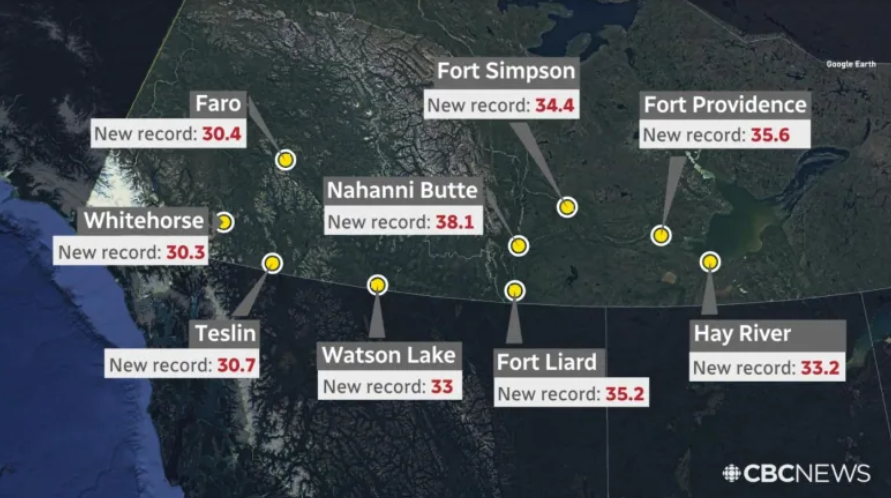N.W.T., Yukon in northern Canada break summer temperature records as heat dome lingers

Temperatures in N.W.T. and Yukon have been rising to new heights over the last week, with 20 daily records broken so far.
Both territories are at the extremities of a “heat dome,” a mass of hot air sitting over the Pacific northwest. The air has caused temperatures to skyrocket in B.C. and Alberta, setting a new national record in Lytton, B.C., at 49.6 C.
David Phillips, a senior climatologist with Environment Canada, said the temperatures aren’t as intense in the two territories as elsewhere right now, but they’re still way above average for this time of year.
“Typical temperatures would be 20, 21 or 22,” he said. “These are excruciatingly, punishingly warm.”
Although the territory has shattered daily highs in a few places, the highest-ever recorded temperature record still hasn’t been broken.
The N.W.T.’s hottest day is still July 18, 1941, when the mercury rose to 39.4 C in Fort Smith, N.W.T.
‘It’s too hot to go anywhere’
Steve Vital hasn’t strayed too far from his air conditioner for the last week.
He’s the chief of Nahanni Butte, a small community of 70 people in N.W.T.’s western mountains. Temperatures there have hovered in the mid-30s for a week, reaching a high of 38 C on Monday, the highest the territory has seen in this heat wave.
The region has seen hot temperatures before, getting up to about 34 C for one or two days every summer, Vital said. The difference this time is how long the hot weather is lasting.
“It’s been quiet for the past week or so because it’s just too hot to go anywhere,” Vital said.
The local band’s been asking people to stay home.
Those who don’t have air conditioning are going to stay with friends and family in the meantime.
Climate change effect Envir
Masses of hot air hovering over part of the country isn’t a new phenomenon, Phillips said.
What is new about this particular heat dome is the fact that it’s staying in place for much longer, bringing more intense temperatures than before.
That’s one result of climate change, he said.
“It’s the heat dome of our grandparents, but it’s revved up,” he said. “It’s just a little bit more powerful.”
High forest fire risk
Philips said the “second act” of this heat wave will be increased fire risk in both territories later this summer.
“The ground is going to be like Rice Krispies — snap, crackle and pop,” he said. “It’s a bit of a heads-up for what the next headline could be … ‘the northwest on fire.'”
As of Tuesday, many parts of N.W.T. are at high or extreme wildfire risk, including Yellowknife, Inuvik and Hay River.
The territory has seen 28 fires so far this season, affecting 7,559 hectares of land.
Relief is on the way in the short term, as temperatures will be back to seasonal norms by the end of the week.
Related stories from around the North:
Canada: ‘Prolonged, dangerous and historic’ heat wave bakes much of western Canada, including North, The Canadian Press
Greenland: Tipping points: can a leaked report tip the scales to climate action? Blog by Irene Quaile
Norway: Climate change hits back at Svalbard, coal mine flooded by melting glacier in Norway, The Independent Barents Observer
Russia: Record breaking temperatures recorded in Arctic Russia, Eye on the Arctic
Sweden: Sweden’s wildfire season later than usual, Radio Sweden



